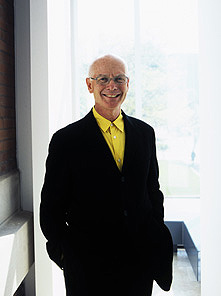 Professor, Faculty of Architecture, Landscape, and Design University of Toronto
Professor, Faculty of Architecture, Landscape, and Design University of Toronto
Larry Wayne Richards has had a major role in Canadian architecture as writer, professional advisor, curator, and educator. He was Director of the University of Waterloo School of Architecture from 1982 to 1987 and Dean of the University of Toronto’s Faculty of Architecture, Landscape, and Design from 1997 to 2004.
Born in Indiana, Richards completed a professional architecture degree at Miami University (Ohio) in 1967, then worked with Walter Gropius and The Architects Collaborative. He completed a post-professional masters at Yale before immigrating to Canada in 1975 to teach at Nova Scotia Technical College and Dalhousie. With Eric Fiss, Brian MacKay-Lyons, FRAIC, and Frederic Urban, MRAIC, he established the experimental Halifax group, NETWORKS.
Richards edited the book CCA: Building and Gardens in 1989, and many of his own conceptual projects are in the permanent collection of the Canadian Centre for Architecture. He co-edited Toronto Places: A Context for Urban Design with Marc Baraness in 1992. During 1995-96, Richards was architectural advisor to Edgar Bronfman, Jr. at MCA/Universal in Los Angeles. And in 1996 he was professional advisor, exhibition designer, and publication coordinator for the Canadian “young architects” ideas competition presented at the Venice Biennale.
In 1997 Richards was appointed Dean of the Faculty of Architecture, Landscape, and Design at the University of Toronto, where he continues as Professor of Architecture.
During his eight-year deanship he transformed the school’s academic programs and served on the University’s Design Review Committee for the selection of architects for campus projects. He created the Faculty’s Eric Arthur Gallery and has coordinated more than 20 public architectural exhibitions there.
Richards serves on the board of the Ontario Heritage Trust. He is an international associate in the American Institute of Architects and a fellow in both the New York Institute for Urban Design and the Royal Architectural Institute of Canada.




Larry Wayne Richards provides eloquent evidence of what a true advocate for architecture can be. Polymath, professional and perfectionist, he uses al his experience and personality to help forward the cause of the beautiful, the useful and the meaningful. He has taught architecture and he has explained what it means to the wider world. The nature of his interventions is caring and the value behind them benevolent. Canada is richer for his interventions.
The Right Honourable Adrienne Clarkson, Hon. FRAIC
For me, Mr. Richard’s life work in architecture exemplifies the principle of advocacy across the fullest spectrum of our profession.
For three decades, Larry Richards has been instrumental in shaping architectural education at leading Canadian universities. As a published author, he has written extensively on architecture and urbanism. His work in curating over 20 exhibitions on architects and architecture has served to bring these works into the wider public realm, thereby heightening public awareness. Mr. Richards has served on numerous boards, juries and committees tasked with selection of architects for many prominent buildings – raising awareness of the profession.
Any single aspect of Mr. Richard’s energetic involvement in his profession speaks clearly to his passion and dedication; taken together, the full sweep of his endeavours to promote architecture and engage the public in architectural discourse marks an exemplary advocate.
Gaye Kapkin, MRAIC
In a society that so often emphasizes economic development at any price, the need to defend the quality of the built environment is more important than ever.
The career of Larry Wayne Richards is an inspiring one that calls on architectural professionals to think about the active role they must all play.
His involvement in promoting architecture takes on even greater significance given his activity in so many areas of the profession, as an educator, administrator and writer. In short, a remarkable career, and a unique and impressive contribution that deserve recognition.
Michel Dubuc, FIRAC